Text and photos by Mary L. Peachin and Montréal Tourism
Vol. 10 No. 10
Adventuring in Québec
(Editor’s note: Québec offers a diverse contrast of activities and attractions. Transversing the Canadian province from west to northeast is a journey through valleys and rivers of the Outaouais then ascending into the mountains of the Laurentians. Great adventures can be combined with the fascinating cultural and historical aspects of Québec’s great cities: Montreal and Québec . In June, we shared some adventures in the Outaouis and Laurentians, this month we feature the cultural of its two wonderful cities: Montréal and Québec.)
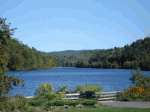 Multi-layered and multi-cultured, Québec’s Montréal is as kissable as the bright cherry-red lips in the “O” of its logo. Beneath its sidewalks there are 20 miles of highways and bridges, subways, contiguous blocks of shopping malls, parking lots; all a massive network which surfaces into dozens of districts or boroughs.
Multi-layered and multi-cultured, Québec’s Montréal is as kissable as the bright cherry-red lips in the “O” of its logo. Beneath its sidewalks there are 20 miles of highways and bridges, subways, contiguous blocks of shopping malls, parking lots; all a massive network which surfaces into dozens of districts or boroughs.
Brick and stone architecture ranges from Scottish to Italian. Upscale residential neighborhoods like Westmount have expansive views overlooking the city. Parc du Mont-Royal, offering year-round recreational activities, was designed by landscape architect Frederick Law Olmstead, the same designer of New York’s Central Park. Bernard, and Sherbrooke streets are only a few of many boulevards offering upscale and trendy shops.
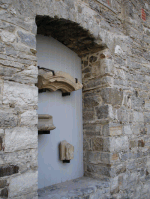 Many of the eighty diverse ethnic groups make their way to Little Italy’s open-air Jean-Talon market for fresh produce and regional delicacies. Yes, Montreal tempts every palate with its approximately 5000 restaurants featuring every type of cuisine. Lower end neighborhoods, maintained by the city, are noticeable only by the presence of nearby bargain and “pay day” loan stores. Exterior metal staircases, which provide additional living space, are typical of middle class neighborhoods. Residents share communal vegetable gardens. Students from McGill, Concordiaand Quebec, and Montréal Universities add vibrancy to the city.
Many of the eighty diverse ethnic groups make their way to Little Italy’s open-air Jean-Talon market for fresh produce and regional delicacies. Yes, Montreal tempts every palate with its approximately 5000 restaurants featuring every type of cuisine. Lower end neighborhoods, maintained by the city, are noticeable only by the presence of nearby bargain and “pay day” loan stores. Exterior metal staircases, which provide additional living space, are typical of middle class neighborhoods. Residents share communal vegetable gardens. Students from McGill, Concordiaand Quebec, and Montréal Universities add vibrancy to the city.
In 1535, Frenchman Jacques Cartier explored the island then inhabited by the Iroquois nation. In 1642, French Catholics missionaries led by Paul de Chomedey, Sieur de Maisonneuve, quickly abandoned their efforts to convert the natives. The fur trade is credited for stimulating the colonization of the area. The French lost a battle for Québec with the British, lasting 20-minutes, in 1759. The city remained English until joining Nova Scotia, New Brunswick, and Ontario in becoming the first provinces of Canada.
 Today, 1.8 million residents live on the island of Montréal (26 by 10 mile wide) with 3.2 million people living within a radius of 45 miles. The St. Lawrence River, Lakes Saint-Louis and des Deux-Montagnes and the Rivière des Prairies surrounded the sizable island. Montréal’s container port loads 25 million tons yearly, and in spite of being located 1000 miles from the Atlantic, a voyage of about 10 days by ship, the port rivals that of New York City.
Today, 1.8 million residents live on the island of Montréal (26 by 10 mile wide) with 3.2 million people living within a radius of 45 miles. The St. Lawrence River, Lakes Saint-Louis and des Deux-Montagnes and the Rivière des Prairies surrounded the sizable island. Montréal’s container port loads 25 million tons yearly, and in spite of being located 1000 miles from the Atlantic, a voyage of about 10 days by ship, the port rivals that of New York City.
A walking tour of Old Montréal begins at the Basilica de Notre-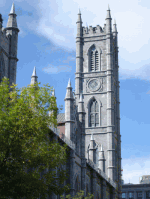 Dame, a church built by the Sulpicians in 1683. The building was rebuilt on a much larger scale under the supervision of architect James O’Donnell between the years of 1824-29. Céline Dion was married in the Basilica and Prime Minister Pierre Trudeau had his funeral there.
Dame, a church built by the Sulpicians in 1683. The building was rebuilt on a much larger scale under the supervision of architect James O’Donnell between the years of 1824-29. Céline Dion was married in the Basilica and Prime Minister Pierre Trudeau had his funeral there.
The Place d’Armes’ fountain honors Paul de Chomedey de Maisonneuve, a city founder. Surrounding the square is the city’s first 8- story skyscraper and the original Bank of Montréal, founded in 1817. Commissioners Saint-Jacques Street was the center of business and many of the original banks are still in business. The Seminary of the Sulpicians Priests, known as the Salvation Brothers is another original building.
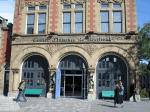 A former bank, now renovated as the posh St. James, was the hotel of choice when the Rolling Stones played a venue in Montréal. Other places of interest include an ornate grey stone English hardware store, a 1903 fire station currently housing a historical museum, and the 1698 Frères Charon hospice run by the Sisters of Charity.
A former bank, now renovated as the posh St. James, was the hotel of choice when the Rolling Stones played a venue in Montréal. Other places of interest include an ornate grey stone English hardware store, a 1903 fire station currently housing a historical museum, and the 1698 Frères Charon hospice run by the Sisters of Charity.
Near the St. Lawrence River, the Lachine Canal locks were built to allow ships a route around the rapids. After passing the waterfront statute of John Young, boss of the port in 1811, the tour ended in an area surrounded by the original 1878 court house, the copper-roofed city hall, and the marketplace of Marché Bonsecours.
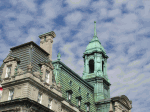 At the foot of King Edward Quay, located in district of Ville-Marie (Montréal’s original name), the 210-foot Cavalier Maxim ship offers harbor tours plying the strong currents (4-7 knots) of the St. Lawrence River. Heading north under the 1931 Jacques Cartier bridge, the sights along the river include the last grain silo in operation and stockyards of woods chips and gypsum being loaded into containers to transfer to freighters. Beyond the banks of the river, the sights of Montréal tower in the background.
At the foot of King Edward Quay, located in district of Ville-Marie (Montréal’s original name), the 210-foot Cavalier Maxim ship offers harbor tours plying the strong currents (4-7 knots) of the St. Lawrence River. Heading north under the 1931 Jacques Cartier bridge, the sights along the river include the last grain silo in operation and stockyards of woods chips and gypsum being loaded into containers to transfer to freighters. Beyond the banks of the river, the sights of Montréal tower in the background.
French-speaking Montréal offers a fascinating history with cultural and residential diversity. So pucker up, Montréal is truly kissable.
If you go:
Air Canada provides service to Montréal: www.aircanada.com or 800.247.2262
Montréal Tourisme : www.tourisme-montreal.org 877-bonjour or 266.5687
Centre D’Histoire de Montréal : 514.872.3207 or www.ville.montreal.qc.ca/chm
Croisières AML Maxim : 800.563.4643 or www.croisièresaml.com
Discover Old Montréal: 800.363.4021 or www.guidatour.qc.ca
La Prunelle Restaurant: 327 Duluth St. East 514.849.8403 Apportez votre vin (a Montréal tradition of bringing your own wine to certain restaurants)
The Mystique of Québec City
“A place where the river narrows”
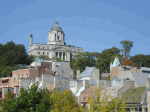 Lively bistros and pubs wedge between locally-owned boutiques, fine art galleries and antique shops, museums, and, yes, even those ubiquitous souvenir shops stuffed with regional souvenirs. Hoofs clatter on cobblestone streets where horse-driven carriages carry spellbound visitors. Historic facades enhance a kaleidoscope of colorful buildings. Unique emblems or signage, hand-painted murals, and flower-filled hanging baskets attract visitors.
Lively bistros and pubs wedge between locally-owned boutiques, fine art galleries and antique shops, museums, and, yes, even those ubiquitous souvenir shops stuffed with regional souvenirs. Hoofs clatter on cobblestone streets where horse-driven carriages carry spellbound visitors. Historic facades enhance a kaleidoscope of colorful buildings. Unique emblems or signage, hand-painted murals, and flower-filled hanging baskets attract visitors.
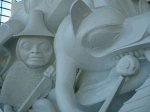 Overlooking the city, the castle-size 618-room Hotel Fairmont Le Chateau Frontenac outlines the skyline. Its bar St.-Laurent’s semicircular design allows visitors to enjoy grand views of the St. Lawrence River. Streets are crowded with busloads of tourists surrounding multi-lingual guides while listening intently to information about points of interest. Unfazed locals go about their business sometimes stopping to relax or sip a cafe au lait in one of many sidewalk cafes. A journey to Québec City is like visiting a European city without having to cross the Atlantic.
Overlooking the city, the castle-size 618-room Hotel Fairmont Le Chateau Frontenac outlines the skyline. Its bar St.-Laurent’s semicircular design allows visitors to enjoy grand views of the St. Lawrence River. Streets are crowded with busloads of tourists surrounding multi-lingual guides while listening intently to information about points of interest. Unfazed locals go about their business sometimes stopping to relax or sip a cafe au lait in one of many sidewalk cafes. A journey to Québec City is like visiting a European city without having to cross the Atlantic.
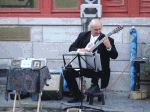 Vieux or Old Québec proudly maintains its charm and distinction of being the only walled city in North America. Its diverse history spans centuries of French involvement with the natives, English, Irish, and Americans, all stories that add to the city’s mystique.
Vieux or Old Québec proudly maintains its charm and distinction of being the only walled city in North America. Its diverse history spans centuries of French involvement with the natives, English, Irish, and Americans, all stories that add to the city’s mystique.
Long before the arrival of Europeans, the region was inhabited by the Huron nation. When explorer Jacques-Cartier landed in America in 1534, he spent his first winter camping near the future site of Québec City. In search of a fur trading passage to Asia, he was disappointed to find that the strong currents of the St. Lawrence River flowed only as far as the Great Lakes. Cartier was further disappointed when the gold and diamonds he discovered turned out to be quartz and iron pyrite.
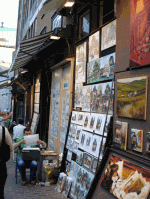 In 1608, Samuel de Champlain built a small trading post which was named Québec City, the New France of America. The strategic location “where the river narrows” on the St. Lawrence made Québec City an ideal location. Towering cliffs provided great visibility and the river’s narrowing restricted unwanted passage to the Great Lakes.
In 1608, Samuel de Champlain built a small trading post which was named Québec City, the New France of America. The strategic location “where the river narrows” on the St. Lawrence made Québec City an ideal location. Towering cliffs provided great visibility and the river’s narrowing restricted unwanted passage to the Great Lakes.
About the same time the British were exploring Virginia in the 1600s, settlers began arriving from France. Québec City spanned an empire stretching as far south as Louisiana.
In 1639, when the population became stagnant, young, orphaned women were imported from France. They were given two weeks to marry and required to birthed 8 to 10 children. The population of the city quickly increased to 10,000 with King Louis XIV encouraging this growth by subsidizing women for child birth. The Sisters of Ursuline blessed the marriages and busily built schools. Fur trading and ship building were the strength of the economy. By 1639, the Sisters of Augustine founded North America’s first hospital in Québec and, in 1663; a silver-roofed seminary was completed.
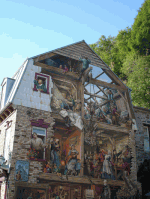 The British followed. Led by James Wolfe defeated Louis-Joseph de Montcalm in a surprise attack fought on the Plains of Abraham in 1759. Then the Irish, fleeing the 1800 potato famine, arrived in Québec where the found work available on the docks. Under British rule, the great wall or citadel was built, one which was never used in battle. Today, the fortification serves as a large recreational city park. And, thankfully, the wall was preserved and maintained. Years later, Britain’s lengthy domination ended with the establishment of Québec as a province before joining the Dominion of Canada in 1867.
The British followed. Led by James Wolfe defeated Louis-Joseph de Montcalm in a surprise attack fought on the Plains of Abraham in 1759. Then the Irish, fleeing the 1800 potato famine, arrived in Québec where the found work available on the docks. Under British rule, the great wall or citadel was built, one which was never used in battle. Today, the fortification serves as a large recreational city park. And, thankfully, the wall was preserved and maintained. Years later, Britain’s lengthy domination ended with the establishment of Québec as a province before joining the Dominion of Canada in 1867.
In Place Royale, one of the city’s oldest neighborhoods, escape fire ladders remain on rooftops and stone firewalls separate dwellings. In later years, Québec City became an important port for grain and the many silos which still operate along the river. Today, Québec is the home of the provincial parliament. The city’s metropolitan area covers 4,000 square miles and 95 percent of its 625,000 residents speak French.
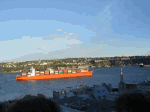 When multiple cruise ships disembark passengers, the narrow picturesque streets of the old city can be as crowded as a holiday weekend at Disneyland. On a sunny autumn day, we opted to avoid the crowds by bicycling ten miles to Ste-Anne-de-Beaupré. Popular Parc de la Chute-Montmorency is a sightseeing wonder. Dating back 900 million years, the Montmorency River plunges 272 feet over rock cliffs. The chute or waterfall is 100 feet higher than Niagara Falls. A suspension bridge spans the chasm. After a picnic lunch, we pedaled back returning the cycles to Cyclo Services located adjacent to the colorful open air market of Marché du Vieux-Port.
When multiple cruise ships disembark passengers, the narrow picturesque streets of the old city can be as crowded as a holiday weekend at Disneyland. On a sunny autumn day, we opted to avoid the crowds by bicycling ten miles to Ste-Anne-de-Beaupré. Popular Parc de la Chute-Montmorency is a sightseeing wonder. Dating back 900 million years, the Montmorency River plunges 272 feet over rock cliffs. The chute or waterfall is 100 feet higher than Niagara Falls. A suspension bridge spans the chasm. After a picnic lunch, we pedaled back returning the cycles to Cyclo Services located adjacent to the colorful open air market of Marché du Vieux-Port.
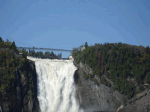 These days a funicular tram transports visitors up and down the 45-degrees hill providing easier access to the upper city. A panoramic view of the city can also be seen from the Société des traversiers du Québec, a 10-minute commuter ferry ride across the St. Lawrence to the community of Lévis.
These days a funicular tram transports visitors up and down the 45-degrees hill providing easier access to the upper city. A panoramic view of the city can also be seen from the Société des traversiers du Québec, a 10-minute commuter ferry ride across the St. Lawrence to the community of Lévis.
Québec City offers dozens of museums tucked between the shops and bistros along cobblestone streets. We had convenient access to them from our small 41 room family-type L’Hótel du Vieux-Québec.
Oui, Québec. Your fascinating history, charm, and culinary delights have been preserved for all of us to enjoy. Merci!
If you go:
The province is located north of Maine and the Appalachian mountains.
Air Canada provides air service to Québec City’s Jean Lesage International Airport: www.aircanada.com or 800.247.2262
Tourisme Québec: 800.266.5687; www.bonjourquebec.com
Québec City Tourism: 418.641.6290; www.quebecregion.com
L’Hôtel du Vieux-Québec: 418.692.1850 or 800.361.7787; www.hvq.com
Portofino Bistro Italiano: 418.692.8888; www.portofino.qc.ca
Cyclo Services: 877.692.4052; www.cycloservices.com
Le Saint-Amour: 418.694.0667; www.saint-amour.com
Le Café du Monde: 418.692.4455; www.lecafedumonde.com
Musée de la Civilisation: 418.692.1650; www.mcq.org
